York University SOSC 1731 Final Exam Essay: Cities and Social Media
VerifiedAdded on 2022/10/09
|8
|1138
|24
Essay
AI Summary
This essay, prepared for a Sociology final exam (SOSC 1731), addresses the evolution of cities and the impact of technology and social media. The essay is divided into two parts, addressing two separate questions from the exam. The first part examines how the form and function of cities changed across pre-industrial, industrial, and post-industrial periods, highlighting the role of technology in each era. It outlines the characteristics of each period and specific technologies used. The second part defines and differentiates between social media and social networks, discussing their similarities and differences. It explores the benefits and limitations of both, considering their impact on society, marketing, and user interactions. The student uses references to support arguments. The essay provides a comprehensive analysis of the changes in urban development, the effects of technological advancements, and the role of social media in contemporary society.
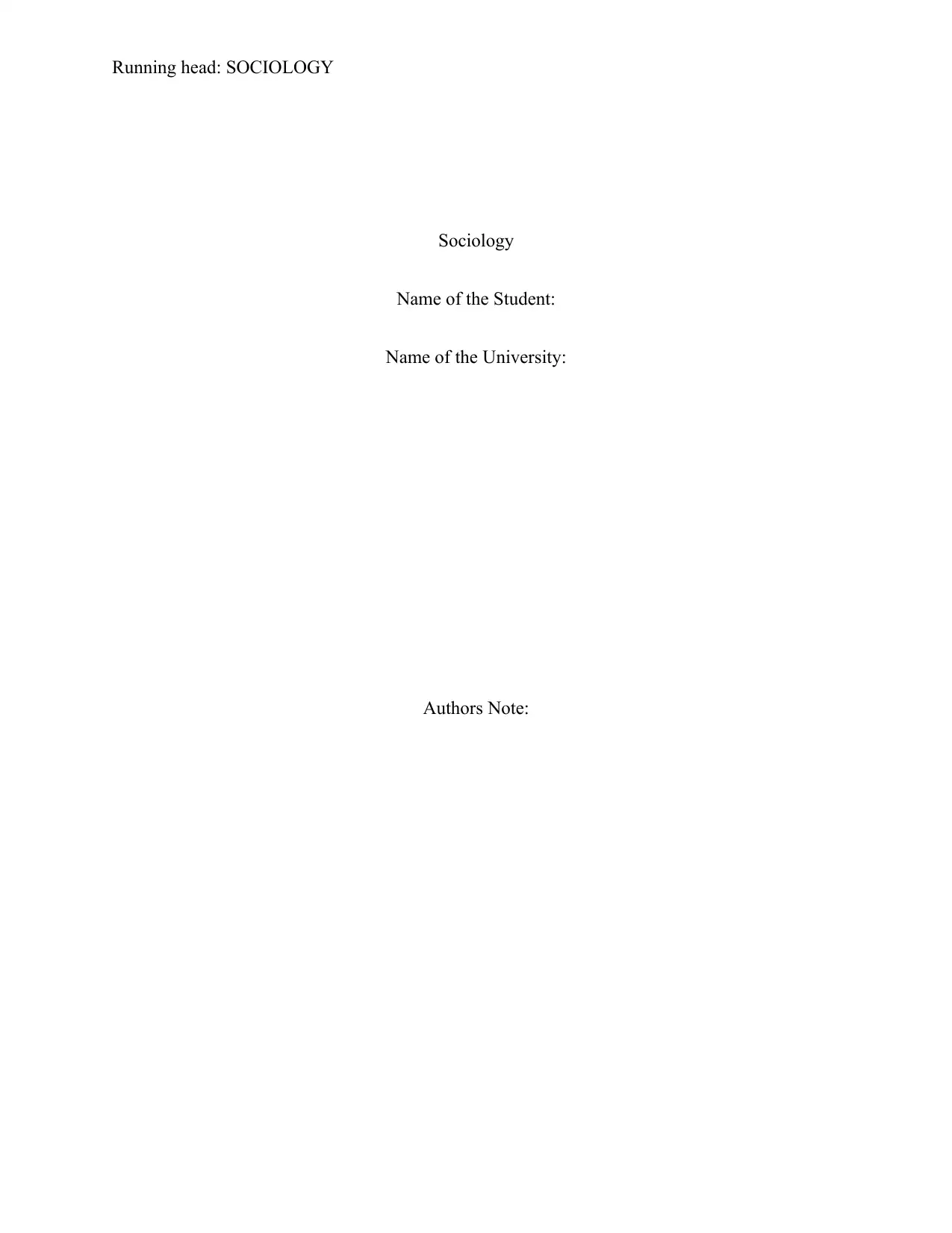
Running head: SOCIOLOGY
Sociology
Name of the Student:
Name of the University:
Authors Note:
Sociology
Name of the Student:
Name of the University:
Authors Note:
Paraphrase This Document
Need a fresh take? Get an instant paraphrase of this document with our AI Paraphraser

1
SOCIOLOGY
Contents
Part 2:...............................................................................................................................................2
Answer A:....................................................................................................................................2
Part 3:...............................................................................................................................................4
Answer C:....................................................................................................................................4
References:......................................................................................................................................7
SOCIOLOGY
Contents
Part 2:...............................................................................................................................................2
Answer A:....................................................................................................................................2
Part 3:...............................................................................................................................................4
Answer C:....................................................................................................................................4
References:......................................................................................................................................7
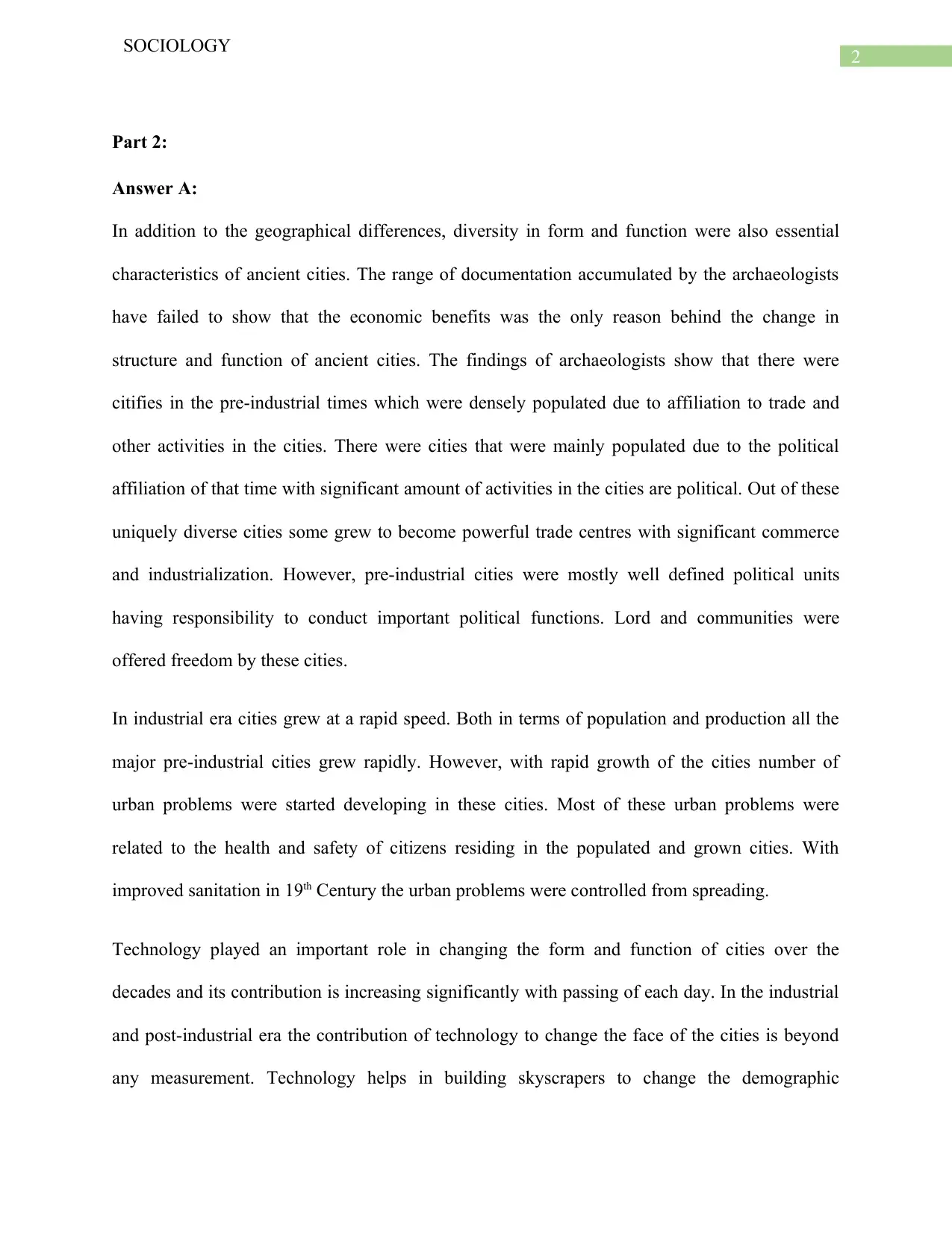
2
SOCIOLOGY
Part 2:
Answer A:
In addition to the geographical differences, diversity in form and function were also essential
characteristics of ancient cities. The range of documentation accumulated by the archaeologists
have failed to show that the economic benefits was the only reason behind the change in
structure and function of ancient cities. The findings of archaeologists show that there were
citifies in the pre-industrial times which were densely populated due to affiliation to trade and
other activities in the cities. There were cities that were mainly populated due to the political
affiliation of that time with significant amount of activities in the cities are political. Out of these
uniquely diverse cities some grew to become powerful trade centres with significant commerce
and industrialization. However, pre-industrial cities were mostly well defined political units
having responsibility to conduct important political functions. Lord and communities were
offered freedom by these cities.
In industrial era cities grew at a rapid speed. Both in terms of population and production all the
major pre-industrial cities grew rapidly. However, with rapid growth of the cities number of
urban problems were started developing in these cities. Most of these urban problems were
related to the health and safety of citizens residing in the populated and grown cities. With
improved sanitation in 19th Century the urban problems were controlled from spreading.
Technology played an important role in changing the form and function of cities over the
decades and its contribution is increasing significantly with passing of each day. In the industrial
and post-industrial era the contribution of technology to change the face of the cities is beyond
any measurement. Technology helps in building skyscrapers to change the demographic
SOCIOLOGY
Part 2:
Answer A:
In addition to the geographical differences, diversity in form and function were also essential
characteristics of ancient cities. The range of documentation accumulated by the archaeologists
have failed to show that the economic benefits was the only reason behind the change in
structure and function of ancient cities. The findings of archaeologists show that there were
citifies in the pre-industrial times which were densely populated due to affiliation to trade and
other activities in the cities. There were cities that were mainly populated due to the political
affiliation of that time with significant amount of activities in the cities are political. Out of these
uniquely diverse cities some grew to become powerful trade centres with significant commerce
and industrialization. However, pre-industrial cities were mostly well defined political units
having responsibility to conduct important political functions. Lord and communities were
offered freedom by these cities.
In industrial era cities grew at a rapid speed. Both in terms of population and production all the
major pre-industrial cities grew rapidly. However, with rapid growth of the cities number of
urban problems were started developing in these cities. Most of these urban problems were
related to the health and safety of citizens residing in the populated and grown cities. With
improved sanitation in 19th Century the urban problems were controlled from spreading.
Technology played an important role in changing the form and function of cities over the
decades and its contribution is increasing significantly with passing of each day. In the industrial
and post-industrial era the contribution of technology to change the face of the cities is beyond
any measurement. Technology helps in building skyscrapers to change the demographic
⊘ This is a preview!⊘
Do you want full access?
Subscribe today to unlock all pages.

Trusted by 1+ million students worldwide
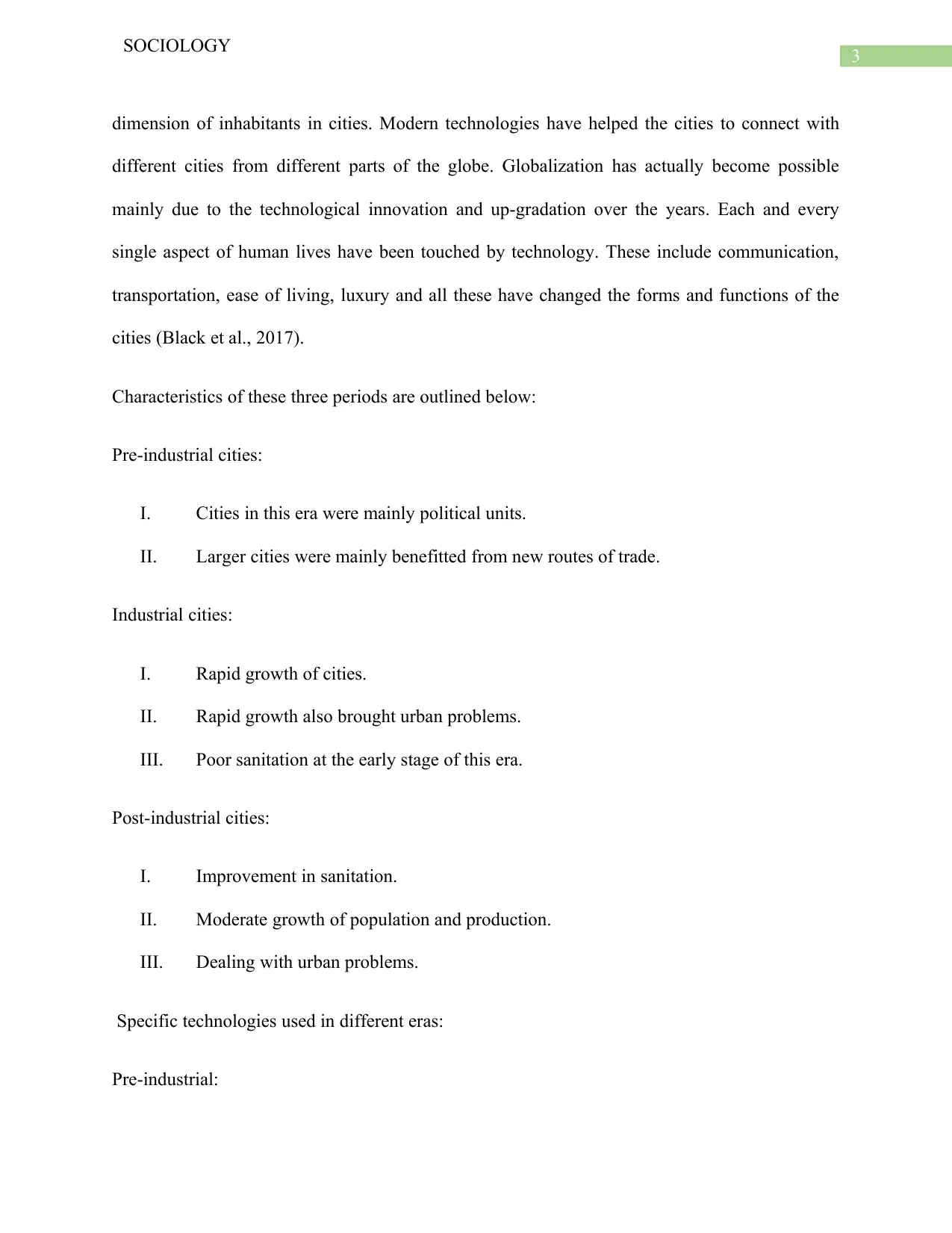
3
SOCIOLOGY
dimension of inhabitants in cities. Modern technologies have helped the cities to connect with
different cities from different parts of the globe. Globalization has actually become possible
mainly due to the technological innovation and up-gradation over the years. Each and every
single aspect of human lives have been touched by technology. These include communication,
transportation, ease of living, luxury and all these have changed the forms and functions of the
cities (Black et al., 2017).
Characteristics of these three periods are outlined below:
Pre-industrial cities:
I. Cities in this era were mainly political units.
II. Larger cities were mainly benefitted from new routes of trade.
Industrial cities:
I. Rapid growth of cities.
II. Rapid growth also brought urban problems.
III. Poor sanitation at the early stage of this era.
Post-industrial cities:
I. Improvement in sanitation.
II. Moderate growth of population and production.
III. Dealing with urban problems.
Specific technologies used in different eras:
Pre-industrial:
SOCIOLOGY
dimension of inhabitants in cities. Modern technologies have helped the cities to connect with
different cities from different parts of the globe. Globalization has actually become possible
mainly due to the technological innovation and up-gradation over the years. Each and every
single aspect of human lives have been touched by technology. These include communication,
transportation, ease of living, luxury and all these have changed the forms and functions of the
cities (Black et al., 2017).
Characteristics of these three periods are outlined below:
Pre-industrial cities:
I. Cities in this era were mainly political units.
II. Larger cities were mainly benefitted from new routes of trade.
Industrial cities:
I. Rapid growth of cities.
II. Rapid growth also brought urban problems.
III. Poor sanitation at the early stage of this era.
Post-industrial cities:
I. Improvement in sanitation.
II. Moderate growth of population and production.
III. Dealing with urban problems.
Specific technologies used in different eras:
Pre-industrial:
Paraphrase This Document
Need a fresh take? Get an instant paraphrase of this document with our AI Paraphraser
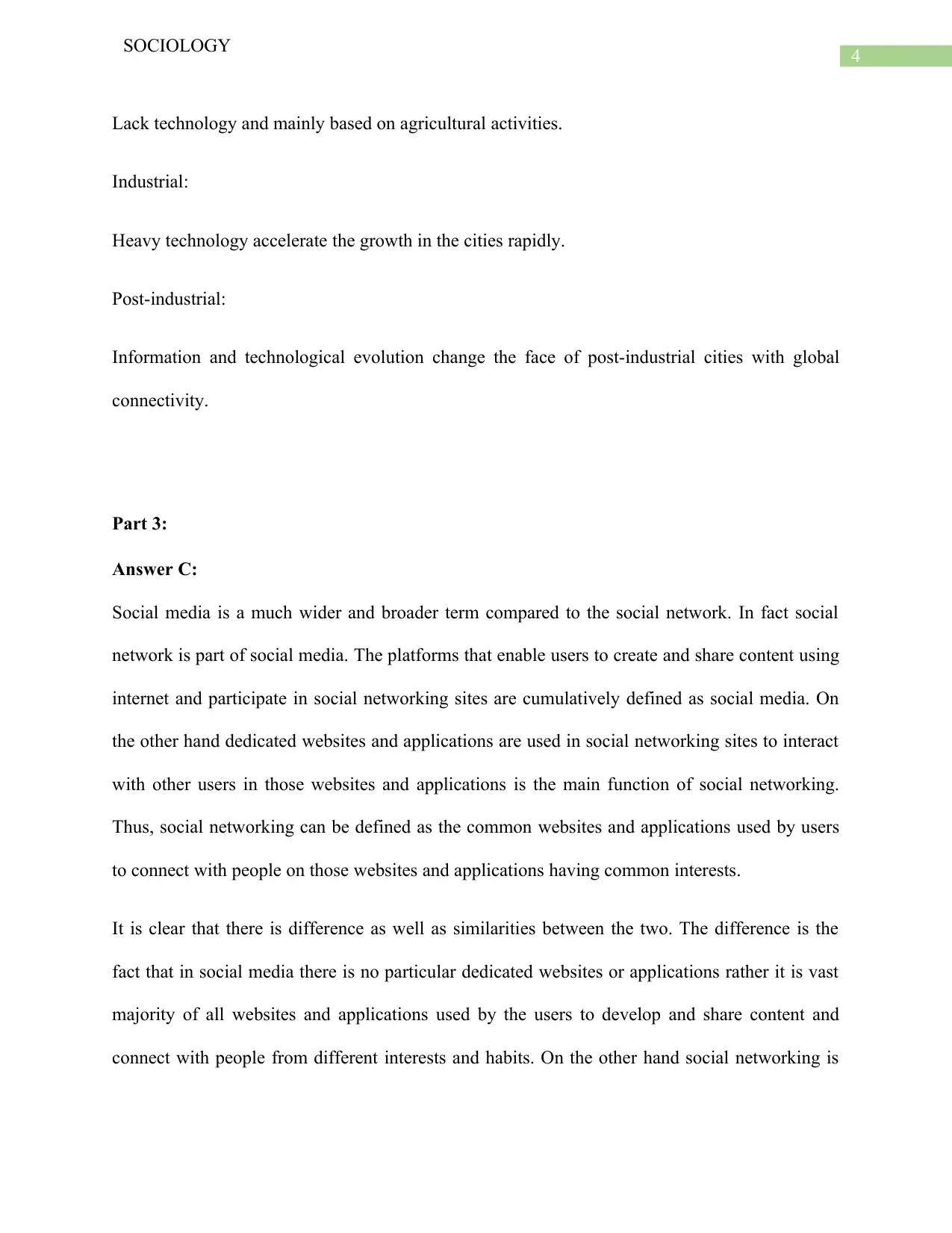
4
SOCIOLOGY
Lack technology and mainly based on agricultural activities.
Industrial:
Heavy technology accelerate the growth in the cities rapidly.
Post-industrial:
Information and technological evolution change the face of post-industrial cities with global
connectivity.
Part 3:
Answer C:
Social media is a much wider and broader term compared to the social network. In fact social
network is part of social media. The platforms that enable users to create and share content using
internet and participate in social networking sites are cumulatively defined as social media. On
the other hand dedicated websites and applications are used in social networking sites to interact
with other users in those websites and applications is the main function of social networking.
Thus, social networking can be defined as the common websites and applications used by users
to connect with people on those websites and applications having common interests.
It is clear that there is difference as well as similarities between the two. The difference is the
fact that in social media there is no particular dedicated websites or applications rather it is vast
majority of all websites and applications used by the users to develop and share content and
connect with people from different interests and habits. On the other hand social networking is
SOCIOLOGY
Lack technology and mainly based on agricultural activities.
Industrial:
Heavy technology accelerate the growth in the cities rapidly.
Post-industrial:
Information and technological evolution change the face of post-industrial cities with global
connectivity.
Part 3:
Answer C:
Social media is a much wider and broader term compared to the social network. In fact social
network is part of social media. The platforms that enable users to create and share content using
internet and participate in social networking sites are cumulatively defined as social media. On
the other hand dedicated websites and applications are used in social networking sites to interact
with other users in those websites and applications is the main function of social networking.
Thus, social networking can be defined as the common websites and applications used by users
to connect with people on those websites and applications having common interests.
It is clear that there is difference as well as similarities between the two. The difference is the
fact that in social media there is no particular dedicated websites or applications rather it is vast
majority of all websites and applications used by the users to develop and share content and
connect with people from different interests and habits. On the other hand social networking is
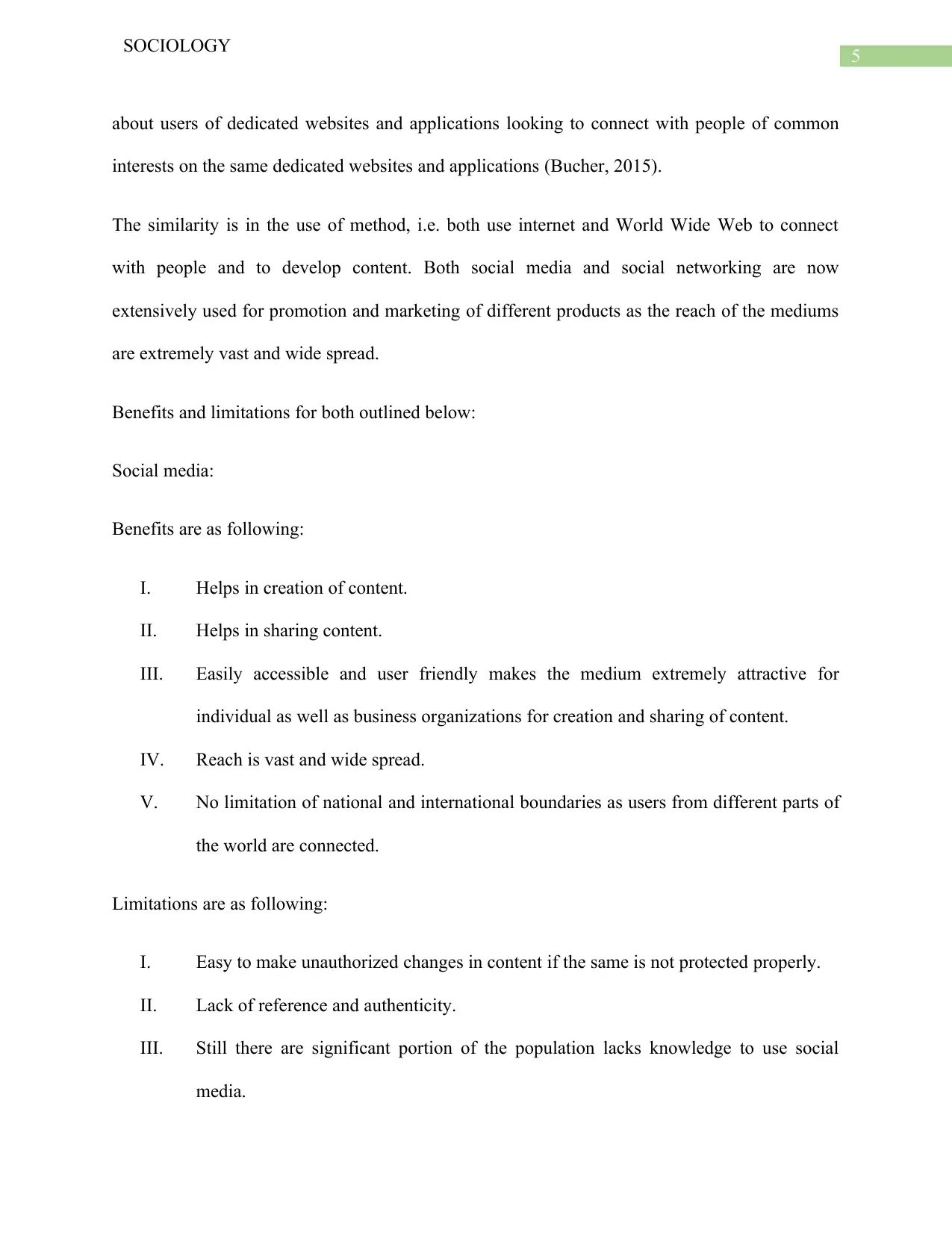
5
SOCIOLOGY
about users of dedicated websites and applications looking to connect with people of common
interests on the same dedicated websites and applications (Bucher, 2015).
The similarity is in the use of method, i.e. both use internet and World Wide Web to connect
with people and to develop content. Both social media and social networking are now
extensively used for promotion and marketing of different products as the reach of the mediums
are extremely vast and wide spread.
Benefits and limitations for both outlined below:
Social media:
Benefits are as following:
I. Helps in creation of content.
II. Helps in sharing content.
III. Easily accessible and user friendly makes the medium extremely attractive for
individual as well as business organizations for creation and sharing of content.
IV. Reach is vast and wide spread.
V. No limitation of national and international boundaries as users from different parts of
the world are connected.
Limitations are as following:
I. Easy to make unauthorized changes in content if the same is not protected properly.
II. Lack of reference and authenticity.
III. Still there are significant portion of the population lacks knowledge to use social
media.
SOCIOLOGY
about users of dedicated websites and applications looking to connect with people of common
interests on the same dedicated websites and applications (Bucher, 2015).
The similarity is in the use of method, i.e. both use internet and World Wide Web to connect
with people and to develop content. Both social media and social networking are now
extensively used for promotion and marketing of different products as the reach of the mediums
are extremely vast and wide spread.
Benefits and limitations for both outlined below:
Social media:
Benefits are as following:
I. Helps in creation of content.
II. Helps in sharing content.
III. Easily accessible and user friendly makes the medium extremely attractive for
individual as well as business organizations for creation and sharing of content.
IV. Reach is vast and wide spread.
V. No limitation of national and international boundaries as users from different parts of
the world are connected.
Limitations are as following:
I. Easy to make unauthorized changes in content if the same is not protected properly.
II. Lack of reference and authenticity.
III. Still there are significant portion of the population lacks knowledge to use social
media.
⊘ This is a preview!⊘
Do you want full access?
Subscribe today to unlock all pages.

Trusted by 1+ million students worldwide

6
SOCIOLOGY
IV. Difficult to fix responsibilities in social media.
Social networking:
Benefits are as following:
I. Easier to connect with people from different corners of the world.
II. Effective place for promotion and marketing.
III. Easy to use.
IV. Cost effective method to market a product or service.
Limitations are as following:
I. Huge number of users in social networking sites are not authenticated users.
II. Fake profiles in social networking sites.
III. Lack of security and control measures.
IV. Irresponsible users often create number of problems.
SOCIOLOGY
IV. Difficult to fix responsibilities in social media.
Social networking:
Benefits are as following:
I. Easier to connect with people from different corners of the world.
II. Effective place for promotion and marketing.
III. Easy to use.
IV. Cost effective method to market a product or service.
Limitations are as following:
I. Huge number of users in social networking sites are not authenticated users.
II. Fake profiles in social networking sites.
III. Lack of security and control measures.
IV. Irresponsible users often create number of problems.
Paraphrase This Document
Need a fresh take? Get an instant paraphrase of this document with our AI Paraphraser
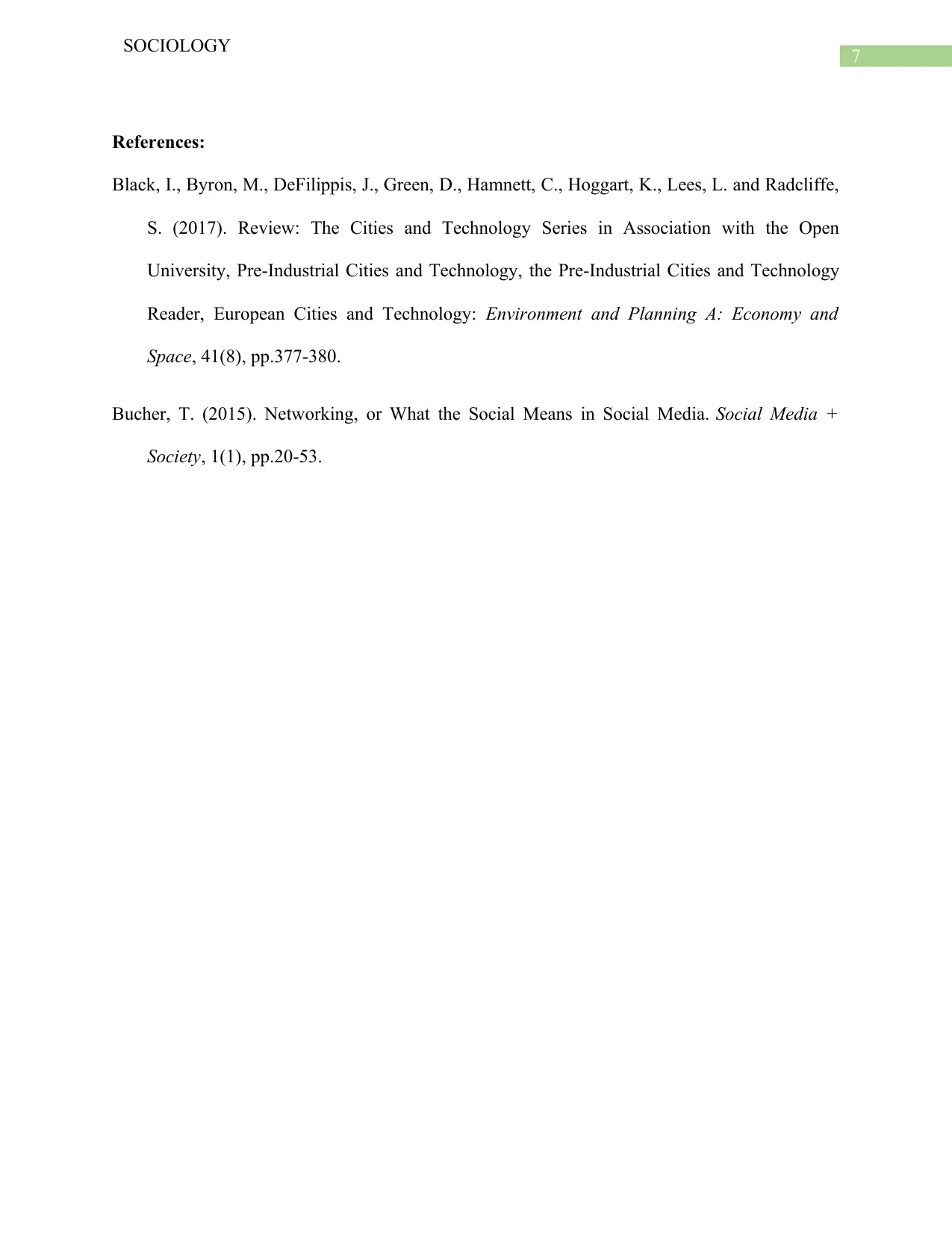
7
SOCIOLOGY
References:
Black, I., Byron, M., DeFilippis, J., Green, D., Hamnett, C., Hoggart, K., Lees, L. and Radcliffe,
S. (2017). Review: The Cities and Technology Series in Association with the Open
University, Pre-Industrial Cities and Technology, the Pre-Industrial Cities and Technology
Reader, European Cities and Technology: Environment and Planning A: Economy and
Space, 41(8), pp.377-380.
Bucher, T. (2015). Networking, or What the Social Means in Social Media. Social Media +
Society, 1(1), pp.20-53.
SOCIOLOGY
References:
Black, I., Byron, M., DeFilippis, J., Green, D., Hamnett, C., Hoggart, K., Lees, L. and Radcliffe,
S. (2017). Review: The Cities and Technology Series in Association with the Open
University, Pre-Industrial Cities and Technology, the Pre-Industrial Cities and Technology
Reader, European Cities and Technology: Environment and Planning A: Economy and
Space, 41(8), pp.377-380.
Bucher, T. (2015). Networking, or What the Social Means in Social Media. Social Media +
Society, 1(1), pp.20-53.
1 out of 8
Your All-in-One AI-Powered Toolkit for Academic Success.
+13062052269
info@desklib.com
Available 24*7 on WhatsApp / Email
![[object Object]](/_next/static/media/star-bottom.7253800d.svg)
Unlock your academic potential
Copyright © 2020–2025 A2Z Services. All Rights Reserved. Developed and managed by ZUCOL.

